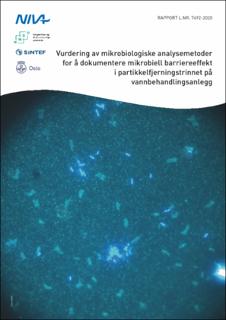| dc.contributor.author | Wennberg, Aina Charlotte | |
| dc.contributor.author | Eikebrokk, Bjørnar | |
| dc.contributor.author | Myrmel, Mette | |
| dc.contributor.author | Hageskal, Gunhild | |
| dc.contributor.author | Hem, Lars John | |
| dc.date.accessioned | 2020-05-04T07:02:40Z | |
| dc.date.available | 2020-05-04T07:02:40Z | |
| dc.date.created | 2020-04-30T11:17:06Z | |
| dc.date.issued | 2020 | |
| dc.identifier.isbn | 978-82-577-7227-7 | |
| dc.identifier.issn | 1894-7948 | |
| dc.identifier.uri | https://hdl.handle.net/11250/2653120 | |
| dc.description.abstract | Det er gjennomført innledende tester med flowcytometri og DNA-baserte metoder for å kartlegge om slike metoder er bedre egnet til in-situ målinger og vurderinger av vannbehandlingsanleggs hygieniske barrierer enn de metodene som vanligvis benyttes. Resultatene viser, ikke overraskende, at ulike mikrobiologiske målemetoder viser ulike aspekter av mikrobiologien og at ulike metoder har ulike fordeler og begrensninger. Resultatene er lovende og arbeidet vil bli videreført i et Norsk Vannprosjekt med deltakelse fra flere vannverk, med ulike råvannskvaliteter og behandlingsmetoder. | en_US |
| dc.description.abstract | To prevent waterborne disease outbreaks and provide customers with safe drinking water, the Drinking Water Regulations (FOR-2016-12-22-1868) require that the water supply must have sufficient hygienic barriers. Hygienic barrier is a measure that reduces the burden of disease-causing microbes, hereinafter referred to as pathogens. New knowledge is needed about the log-reductions that can be achieved for various pathogens, especially viruses, at typical Norwegian water works, under Norwegian conditions and operating conditions. There is also a need for more knowledge about the possible presence of pathogens in return flows in coagulation filtration plants. This is essential for how these flow lines are handled, e.g. whether maturation water can be used for flushing filters or returned to raw water, as well as for hygienic assessments regarding the return flows to the recipient. The knowledge of log reductions at Norwegian water works is largely missing because of a lack of good and sensitive analytical methods for determining low levels of pathogens or good pathogen indicators. In recent years, there has been significant method development for the analysis of various pathogens or pathogen indicators. The new methods have made it possible to analyze a wider range of microbes, including those that cannot be cultured, thus, acting as broader indicators of pathogenic bacteria and viruses. Hygienic barriers are assessed based on the reduction of pathogens on a log10 scale. Raw water normally has low concentrations of pathogens that are only sporadically detected by current methods, thus, alternative methods or surrogates/indicators as a substitute for pathogens must be considered. A peer review of available literature has been carried out for alternative methods for use in assessing the barrier effect of the particle removal stage. The methods described in this report include assessing different strategies for viruses, bacteria and parasites. For viruses, the use of model viruses such as Pepper mild mottle virus as an alternative fecal indicator, spiked-in with somatic coliphages and quantification of all viral particles in water with flow virometry are discussed. Alternative bacterial methods described in the report include different methods of quantification of all bacteria in water: by cell counting with flowcytometer, DNA quantification with digital PCR for the 16s gene of bacteria and activity measuring adenosine triphosphate (ATP). In addition, one can analyze which bacteria are present using sequencing of 16s. For parasites, some alternative surrogate parameters are described as spore forming bacteria and microspheres. Flow virometry for viruses and flow cytometry, digital droplet PCR and sequencing for bacteria have been established and tested in this project for further use in an additional project. All these methods provide information of the importance for the assessment of hygienic barriers. The various methods have strengths and weaknesses; For example, both ATP analyses and flow cytometry are tested, but they do not distinguish between bacteria originating from the raw water and bacteria that grow in the water treatment plant. DNA-based measurement methods are a rapidly evolving field, however, requiring some processing before they can be used for assessments of hygienic barrier effect at the species level. | en_US |
| dc.language.iso | nob | en_US |
| dc.publisher | Norsk institutt for vannforskning | en_US |
| dc.relation.ispartof | NIVA-rapport | |
| dc.relation.ispartofseries | NIVA-rapport; | |
| dc.subject | Molekylærbiologiske metoder | en_US |
| dc.subject | Methods in molecular biology | en_US |
| dc.subject | Mikrobiologi | en_US |
| dc.subject | Microbiology | en_US |
| dc.subject | Biologiske analysemetoder | en_US |
| dc.subject | Biological Assay | en_US |
| dc.subject | Analysemetoder | en_US |
| dc.subject | Analytical methods | en_US |
| dc.subject | Drikkevannsrensing | en_US |
| dc.subject | Drinking water treatment | en_US |
| dc.title | Vurdering av mikrobiologiske analysemetoder for å dokumentere mikrobiell barriereeffekt i partikkelfjerningstrinnet på vannbehandlingsanlegg | en_US |
| dc.title.alternative | Evaluation of microbiological methods for assessment of microbial barrier effect of the particle removal step in drinking water treatment plants. | en_US |
| dc.type | Research report | en_US |
| dc.description.version | publishedVersion | en_US |
| dc.subject.nsi | VDP::Matematikk og naturvitenskap: 400 | en_US |
| dc.subject.nsi | VDP::Mathematics and natural scienses: 400 | en_US |
| dc.source.pagenumber | 42 | en_US |
| dc.source.issue | 7492 | en_US |
| dc.identifier.cristin | 1808802 | |
| dc.description.localcode | 180382 | en_US |
| cristin.ispublished | true | |
| cristin.fulltext | original | |
